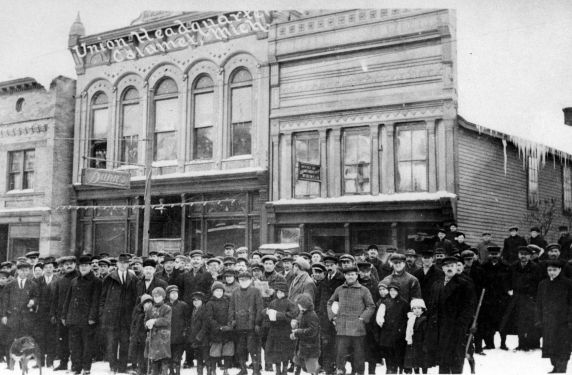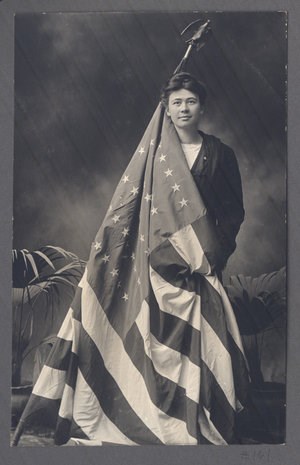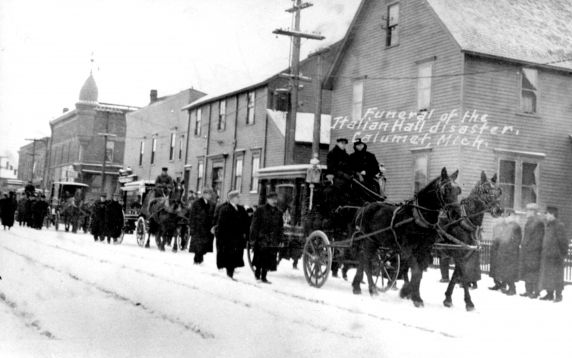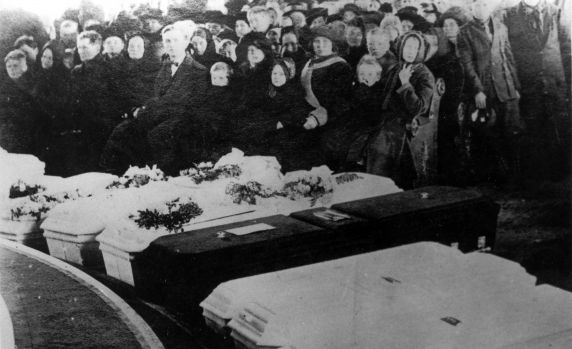In this post I want to bring attention to the Christmas Eve Italian Hall Disaster. This event is a forgotten piece of history to those outside of the local area. This story takes place in the early 1900s during a time where big corporations were booming and there were essentially no restrictions on how an employer could choose to treat their work force. It begins with local workers who became fed up with the way they were being treated and realized that they should be worth more to their employers. With great sacrifice to many union families, a strike begins. Unfortunately, it will end in a Christmas tragedy, but there will be a legacy that these families left behind. It should not be forgotten.
This story takes place in the Copper Country of the Upper Peninsula of Michigan, specifically in a town called Calumet. This town is located on the Keweenaw Peninsula and was originally called “Red Jacket”. By the 1840s, American industrialists had realized the exceptional quality and the abundance of copper found in the Upper Peninsula which triggered a copper rush. The 1840s-1870s brought experienced miners from the United Kingdom, Germany and Ireland to settle in boarding houses and take on the difficult work of mining copper. Michigan played an important role in the overall industrialization of America and the state became the top copper producer in the country.

Large copper companies began to form as a result of this boom. Calumet and Hecla Mining Company, formed in 1865, created an empire in Calumet. They had hired over 21,000 employees by 1907. They owned hundreds of acres above land and over 7,000 ft below. These companies created towns for their workers and families and owned everything in the town. They built the houses and amenities that the workers used and lived in. They owned the schools (which would train future generations of miners), the libraries, etc. This would supplement the low wages that the men received doing the dangerous work underground. Men would work six days a week at 10 to 12 hours per day. Skilled labor would receive $3 per day while unskilled (many of the later immigrants) would receive less than $2.
By the 1900s, new immigrants became attracted to the mining industry in Michigan. These included Eastern Europeans, Southern Europeans and Finnish immigrants. Calumet had an extremely large Finnish population and today Michigan’s Upper Peninsula still holds the largest concentration of Finnish Americans in the United States. The towns the mining companies made held very distinct ethnic lines and many of the workers and their families did not speak English. It kept the workers divided.

A career as a miner may sound like it has great perks as the housing was provided for and your children are provided with an education. Yet, it was not as good as it seemed on the surface. Since the mining companies owned your home and everything else in your town. The company could evict you and your family out for any reason with a 15 day notice, they could evict you and your family with no notice if you were fired, and they could evict your widow and children if you died in the mines. They had to make room for your replacement.
Mining was a dangerous job and thousands of men were either killed or injured every year. 1 out of every 200 men would die by the end of each year, yet this was a risk many immigrants were willing to take. Copper mining was the most dangerous occupation in America. Men worked in darkness for ten hours a day and only the light of two candles would guide them as they dug through the earth. The skilled workers would be using drills and blasting while the unskilled often were trammers. They would load the minerals onto the mine cars and transport it out. This was one of the most dangerous jobs and often these jobs were assigned based on ethnicity and race. The Eastern Europeans, Italian and Finnish immigrants were given these undesirable jobs. Despite the risks involved, medical expenses were not covered for these workers.

James MacNaughton, “the Czar of the Copper Country,” was the general manager for Calumet and Hecla at the time of the strike. He was devoted to the business of the mine and worked hard to cut costs and increase production. He was not afraid of being unlikable and was not afraid of stepping on toes as well. He did not hold much sympathy for his employees. He wanted to eliminate inefficiencies to compete with the open pit copper mines in the West . He became interested in new technology in the mining industry, the one-man drill. Previously, these types of drills were operated by two men, but with the introduction of this new drill it would cut costs and double the productivity of the mine. Despite language barriers between many of the workers, they could still see what this meant. They knew that 50% of them would lose their jobs and it was a risk to their safety. Having a partner in the mines was a protection for yourself, if something happened to you there would be another person available to assist you or get help. With the new drill, the worker would be all alone in the darkness of the mines and it could be a long time before anyone would find them in an emergency. The one-man drill was extremely unpopular.

The anger led the Western Federation of Miners (WFM) to come to the Copper Country in 1912. They were led by their president Charles Moyer. The WFM had been working with the miners who were striking in Western America and held experience facing a tough opponent. In the Copper Country, the union would be focused on three main items: higher wages, 8-hour day, and the end of the one-man drill. One of the messages in the Federations constitution was: “We assert that the working class, and it alone, can and must achieve its own emancipation.” In the Copper Country, the WFM brought all of the different ethnic backgrounds of workers together by creating literature that was published in all every language. They had multiple speakers who could give speeches in each language. Finally, these workers and their families could come together.
The strike began July 23, 1913 when 14,000 miners in three counties dropped their mining tools and shut down the mines completely on the first day of the strike. This was organized by the locals and the WFM was there to support. The strikers had rallies and daily parades to keep the spirit of those in the union high. The strikers would physically stop workers from attending work by blocking the entrances to the mines.

Women also played a large role in the strike. Most notable was Annie Clemenc, a Slovenian woman who became the face of the strike in the media as she carried the American flag and lead the daily parades. She became known as the “American Joan of Arc” by the national media. She was very tall at 6” 2” and became an inspiration for the strikers of Calumet. The women formed The Calumet Women’s WFM auxiliary local #15. Women felt that it was an honor to be a member of the union and over 800 women joined. The women organized themselves along the picket line each day and were crucial in keeping the strikes alive. They knew the risks of mining for their family, so this strike was to their advantage as well. The women were agitators and dominated the front lines of the parades.
What the strikers did not think through was the strength of Calumet and Hecla Company. The lack of workers and the empty mines was not an immediate threat to MacNaughton as the company had large amounts of cash reserves and copper that had yet to be sold. They would be set for much longer than the strikers would before they began to starve without wages. MacNaughton begin to hire replacements to take over for the workers who had left on the strikes. These were always more immigrants desperate for a new life in America. The company paid agencies in New York City to employ immigrants right off the boat. The company would pay for their train ticket (though the workers would have to pay this back). The mines were beginning to open again with the replacements and the strikers could see that they were beginning to lose ground.
The strikers began to ramp up the violence and to seek out more fights as a result. This would include assaulting those who tried to get to work and throwing rocks. Women were involved as well in the violent tactics and defended the strikers, including an incident using feces covered broom. These fights were to defend themselves as MacNaughton called in the National Guard and began to hire “strike breaking” thugs from New York and Chicago. These thugs were often deputized by the sheriff and their duty was to arrest and fight strikers. Spies were also hired by the company to listen to union meetings and report back movements. Mine management and those who opposed the strike formed the Citizens Alliance, which had about 8,000 members. These people wanted to end the “socialism” of the WFM. They were paid by mine management with cash and other goods to go out and oppose the picketers.

“Kill me…Run your bayonets and sabers through this flag and kill me, but I won’t go back. If this flag will not protect me, then I will die with it,” is a quote by Annie Clemenc after the National Guard captain threatened to wrench the flag from her hands. It shows the determination of these women who would fight any obstacle before them. Many strikers, including women, would be arrested and placed in jail due to their participation in the strike and violence. Clemenc was arrested more than once during her strike. Tension were high in the Copper Country as it was an all-out war between the militia and the union strikers. Violence came from both sides through verbal abuse, rock throwing, and fights with both men and women. In one instance, a fourteen-year-old girl was shot and killed during an altercation between picketing women and the deputies they faced off against. The gun was fired by the deputies. Others would also give their lives to keep up the strike they believed in.
By Autumn, the spirits of the strikers and the union members were extremely low. The strike was still active, but the mine was had opened. The strike was also taking an economic toll on the workers and their families as people began to starve and suffer from malnutrition. The union had used all their saved-up funds. The striker’s homes did not have heat for the upcoming winter season and the public parades were becoming less frequent. The striking families were living off donations by sympathizers. Many families began to leave the Upper Peninsula as Henry Ford was offering $5 per day to work in his auto factory in much safer conditions which led to a decline in the strike force. MacNoughton was ready to give his ultimatum and threaten the strikers that they would lose their jobs if they did not give up these demands. It was a terrible holiday season which lead to Annie Clemenc and the women’s auxiliary to put together a Christmas event for the children. This event was to lift the spirits of all the members of the union and give the strike the boost it needed. She used donations to make sure every child had a small gift of fruit or candy.

The party was to take place in the Italian Hall on December 24, 1913 on the second floor. This floor contained a large meeting hall and a stage. It was decorated with a Christmas tree and there was a Santa Claus to meet with all the children. Together they would sign a variety of hymns in different languages representing each culture. To enter the second floor, one would have to climb up a single staircase that was six feet wide. This party was only open to union members and cards were shown at the entrance. There were 600-700 people who attended the party. The hall was packed with people.

By the end of the party, this “security” had become more relaxed. At some point in the evening, as stated by witnesses, a man had crept up the stairs. He wore a coat with the collar turned up and his hat pulled over his eyes. Many claimed that this man was wearing a Citizens Alliance button upon his coat, but this has never been confirmed. He yelled two cries of “Fire!” into the hall and then disappeared. It was enough to cause a panic as a stampede of children and adults rushed down the small stairwell. The fire did not exist. Annie Clemenc and the other women of the auxiliary attempted to calm the crowds and encouraged them to sit back down. They were drowned out by the screams and cries. Someone tripped as they rushed down the stairwell which caused a domino effect. From here, the bodies began to pile up. Everyone collided into each other and were unable to move or stand back up. Adults and children were beginning to die from suffocation and from being crushed to death from the pile up on the stairs.
People who heard the cries on the street attempted to run to the doorway to break through the pile including a local storeowner, Charles Meyers, who stated, “I ran out the store door…when I got to the front entrance I saw a mass of mostly children mixed up and tangled in one mass in front of the door…I tried to pull some of these children but I could not. They were so tight and tangled up I could do nothing.”
The fire department was called and since the attempts to pull people free at the front of the door was not working, they decided to use the fire escape (which no one had thought to use previously) to enter from the back. After the pile up had been broken, they were able to retrieve those who had perished. It was a terrible day for those of Calumet, Michigan. There were 73 dead and over 60 of that number were children. Due to this disaster and the false calls of fire, some parents lost every single one of their children and some children became orphans. Calumet was not prepared to handle a disaster of this scale, so a temporary morgue had to be made of the Town Hall and small child size coffins had to be express shipped from other parts of the state. On December 28, 1913 there was a mass funeral service for all who had perished. There were hundreds who joined in the procession to the cemetery and eulogies were given in a variety of languages. The miners had personally dug the trenches in the cold and frozen ground. Calumet and Hecla offered $5,000 as a relief fund and the Citizens Alliance raised money for the families, but the families of the union rejected this charity. They wanted justice.


The WFM’s president, Charles Moyer, sent telegrams to the governor, the president, etc. to demand an investigation into the Italian Hall Disaster. He wanted an investigation to determine if the Citizens Alliance had any involvement in orchestrating this disaster. These inquiries scared Calumet and Hecla and the company began to use the sheriff to threaten Moyer. Moyer refused to stop fighting for this ended up beaten up by thugs who shot Moyer in the back and threw him on a train to Chicago. It seemed the telegrams worked and in 1914 a delegation of five US Congressmen were sent to mediate between the strikers and the Company. MacNaughton and the mine managers still refused to give way to the strikers demands.
By spring 1914, Congress ended the investigation and the conspiracy around the Italian Hall was abandoned. The Union had no funds left to continue the strike, so after almost a year it ended. The strikers had to return to work. Only half were given their job back under a few conditions. They had to officially gave up the Union. They all had to contribute five cents towards a watch for James McNaughton as a thank you to him for breaking the strike and they all had to each personally sign the thank you letter which accompanied this “gift”. This was all to get their jobs back. It was at this moment that many researchers point to the decline of the Copper Country in Michigan. Many families moved to find better jobs, such as the Ford Motor Company. The price of copper began to increase and due to the location and geology of the Upper Peninsula, it cost more to mine copper here than in the southwest of America. The last Copper mining company closed in the 1960s.
What was the legacy of the Copper Strike of 1913/1914 and the Italian Hall disaster if it ended in failure? Annie Clemenc, the strike, and the Italian Hall Disaster were all national headlines and brought attention to the strikers demands and what they suffered. It showed the courage of the women and men who walked the picket lines. After these events, Congress declared that the federal government would begin to step in to mediate more of these types of events in order to encourage the opposing parties to come to a compromise. The government would begin to regulate hours in the railroad business and establish child labor laws. It inspired laws that would place restrictions on large companies who previously had the freedom to exploit their workers. It brought attention to what people suffered daily to earn a living. The strike in the Copper Country had influence on future strikes and pushed the government to take action.
In 1984, the Italian Hall was demolished. It had become an unsafe building because of its age, and it was an ugly reminder of a tragedy. Today the doorway is left as a memorial and a garden was created. Each year on Christmas Eve, 73 lights are placed through the garden as a memorial to the victims of the tragedy.

Sources:
https://www.missedinhistory.com/podcasts/italian-hall-disaster.htm
http://michiganhistory.leadr.msu.edu/strike-of-1913/
PBS Documentary, Red Metal: The Copper Country Strike of 1913 , https://www.pbslearningmedia.org/resource/debe0fae-524a-4df3-a0b5-7e2bfb8bc756/red-metal-the-copper-country-strike-of-1913-full-program/#.XfQ55ehKiUl
https://finlandabroad.fi/web/usa/finns-in-michigan
https://www.mlive.com/news/2017/12/1913_italian_hall_disaster_was.html
https://www.mininggazette.com/news/features/2016/02/james-macnaughton-becomes-superintendent-of-c-h/
“The Italian Hall Tragedy, 1913: A Hundred Years of Remediated Memories” by Anne Heimo from the book The Twentieth Century in European Memory: Transcultural Mediation and Reception. https://www.jstor.org/stable/10.1163/j.ctt1w8h377.16
Annie Clemenc and the Great Keweenaw Cooper Strike by Lyndon Comstock
Hard Rock Epic: Western Miners and the Industrial Revolution, 1860-1910 by Mark Wyman
“Seems Like Yesterday: Community Memory and the Michigan Cooper Strike, 1913-2013” by Lindsay Hiltunen. Published in Western Illinois Historical Review 2014
Fiction:
Inspired by Women of the Copper Country: A Novel by Mary Doria Russell. This was one of my favorite historical fiction books I have read this year.
One thought on “The Italian Hall Disaster and the Copper Strike of 1913”